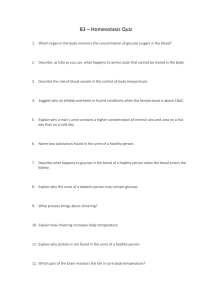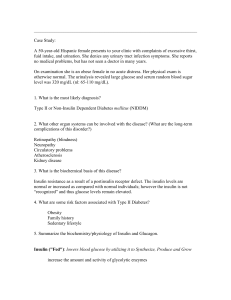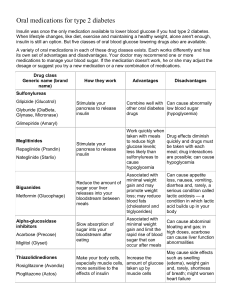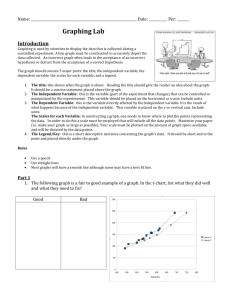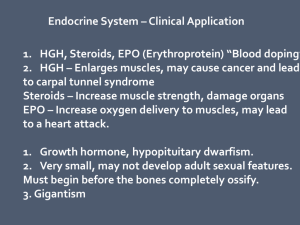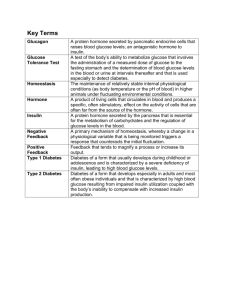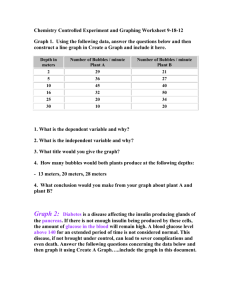Endocrine Disorders: Glands, Hormones, and Conditions
advertisement
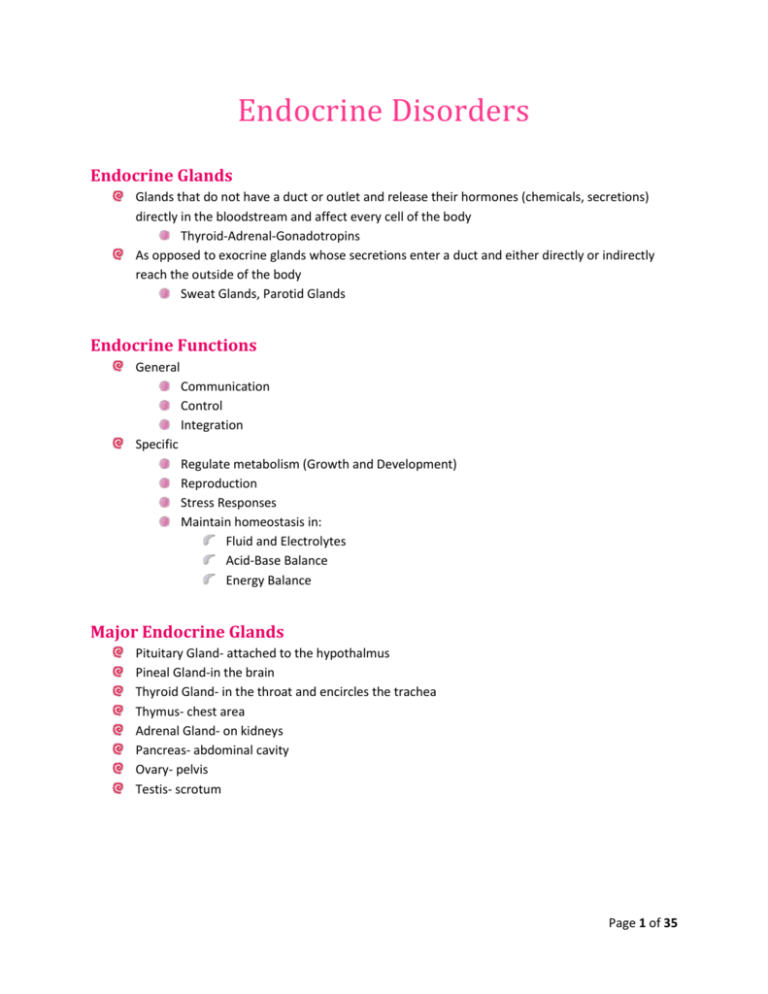
Endocrine Disorders Endocrine Glands Glands that do not have a duct or outlet and release their hormones (chemicals, secretions) directly in the bloodstream and affect every cell of the body Thyroid-Adrenal-Gonadotropins As opposed to exocrine glands whose secretions enter a duct and either directly or indirectly reach the outside of the body Sweat Glands, Parotid Glands Endocrine Functions General Communication Control Integration Specific Regulate metabolism (Growth and Development) Reproduction Stress Responses Maintain homeostasis in: Fluid and Electrolytes Acid-Base Balance Energy Balance Major Endocrine Glands Pituitary Gland- attached to the hypothalmus Pineal Gland-in the brain Thyroid Gland- in the throat and encircles the trachea Thymus- chest area Adrenal Gland- on kidneys Pancreas- abdominal cavity Ovary- pelvis Testis- scrotum Page 1 of 35 Anterior Pituitary- Adenohypophysis- Master Gland Growth Hormone-Somatotrophic Hormone- Stimulates the buildup of protein and muscle mass Causes a shift of the use of carbs for fuel to fats. This is why young person has leaner mass. Can cause elevation in glucose level. Lactogenic Hormone or Prolactin- to produce milk Thryotrophin (TH)- also called Thyroid Stimulating Hormone (TSH) Adrenocorticotrophin (ACTH)- stimulates the cortex of the adrenal glands Two Gonadotropins: Female: Follicle Stimulating Hormone (FSH) and Luteinizing Hormone (LH)- egg release Male: FSH and ICSH- Interstitial Cell Stimulating Hormone- produce sperm and testosterone Melanocyte-Stimulating Hormone- genetically controlled and influences skin color Posterior Pituitary- Neurohypophysis Oxytocin- uterine contractions ADH- Anti-diuretic hormone- affects the kidneys to reabsorb water Both men and women have some Prolactin and oxytocin- thought needed for sexual maturation For every hormone produced in the pituitary, there is a releasing gland produced in the hypothalmus that tell the pituitary gland when to release the needed hormones. Hypothalmus-Computer System Command and control center by manufacturing and releasing hormones that stimulate trophic hormones from the anterior pituitary gland to stimulate a specific gland to release its own hormones Also manufactures oxytocin and ADH and sends it down the capillary system and stored in the posterior pituitary gland until needed Anytime you are under stress, the immune system can attack the glands and cause disorders Page 2 of 35 Biologic Feedback Loop 1. 2. 3. 4. Hypothalmus secretes Thyroid releasing Hormone-TRH Releasing Hormone causes Anterior Pituitary Gland to secrete Thyroid Stimulating Hormone-TSH Bullet sent to Thyroid Gland causing Thyroid to secrete its hormones T3-T4-Calcitonin goes directly into the blood stream to affect every cell in the body Feedback The blood level of hormone needed or not needed determines how much stimulation the hypothalamus receives Hypothalamus determines blood level is high- less stimulation to the thyroid then T3-T4 level will drop Never abruptly stop steroid med like Prednisone- taper dose Hypo does not differentiate between endogenous (inside body)/exogenous (outside body) steroids Hypo goes on vacation and will take time to increase the body’s own production of steroids Patient will crash! Hyperpituitarism Caused by benign adenoma Secreting tumor- causes more hormone level than is normal In the brain- space occupying lesion laying on optic chiasma where optic nerve criss-crosses in brain: Hemianopia (loss of half of visual field)/visual problems- Seizures- headaches Page 3 of 35 Hyperpituitarism- Overproduction of Growth Hormone Acromegaly- Abraham Lincoln Large hands, nose, feet, ears, facial bones/jaw- in adult Giantism (if occurs as child) (8 ft. tall) May also have: Hyperthyroidism-Cushing’s-Reproductive Problems Diagnosis Skull x-rays, CAT scans, MRI’s Serum and Blood Tests Treatment: Surgery Irradiation Parlodel-Bromocriptine mesylate which decreases GH production Growth Hormone causes blood sugar levels to increase by burning fat for metabolism rather than carbs- glucose stays in the blood May need to treat with insulin Surgery Hypophysectomy- old term Craniotomy Transphenoidal Hypophysectomy done above the gum line through the sphenoid sinus behind the nose into the brain Nursing Care I&O- removed pituitary gland- no ADH- Diabetes Insipidus where one excretes large amount of dilute urine- measure urine specific gravity (1.003- 1.035) and electrolytesshock Hormone replacement therapy for the rest of their lives ADH- Desmopressin, Vasopressin tanate, Pitressin either IM or sniffed Brain surgery- decrease brain edema and increased intracranial pressure Low fowler’s position reduces cerebral edema and IICP No bending, coughing, or vomiting If clear liquid drainage- check for glucose- if present CSF!!! Danger of infectionAntibiotics- Mouth is dirty No tooth brushing for a short period Page 4 of 35 Hypopituitarism Diagnosis: same way Sx: headache, visual problems, growth retardation (Premature aging, dwarfism) Treatment: Replace all hormones- Essential for life Stress increases demand for hormones and taxes the system Thyroid Gland Secretes 3 hormones Thyroxine- T4 Triiodothyroxine- T3 Calcitonin- reroutes calcium from blood to bones and lowers the blood calcium level Prevents Hypercalcemia Normal Calcium 8-10 mg/dL Shaped like a butterfly over the trachea Iodine’s Role Body must have Iodine to make thyroid hormones- T3 and T4 Insufficient Iodine causes goiters Problem for Iodine deficient soil but is les problematic with Iodized table salt T4 contains 4 iodine atoms and secreted abundantly T3 contains 3 atoms of iodine Both regulate metabolism and growth and development Diagnosis T3- 70-22- mg/dL T4- 4.5-11.5 ug/dL TSH RAIU- Radioactive Iodine Uptake Test Thyroid scan- I-131 given and scanned for density No iodine before test- no seafood parties- discuss Cardiac cath verses thyroid scan (cardiac cath can interfere with thyroid test because of the radioactive iodine. Do thyroid test first unless emergency cath) ? Thyroid med stopped- ask MD (Estrogen and Birth Control can contain Iodine) T3 Resin Uptake- blood drawn and I 131 is added afterwards- normal RBC uptake is 11-19% uptake BMR done- determine amount of O2 consumed by body per minute- No smoking, no activity, done upon awakening- NPO after MN- clamp nose and breath into a machine Page 5 of 35 Mrs. Myxedema has hypothyroidism Slow burning fire inside the body Thermostat is set low Slow metabolism Decreased metabolic rate Heart Rate: 50-60 bpm- CHF Resp rate: 6-8/min Temp: always cold Activity: easily fatigued GI: Constipation Says: “Turn up the heat! Give me another blanket! Put my socks on, please! Help me out of bed!” Don’t use heating pads- neurovascular response is offset- peripheral nerves die and won’t be able to feel it burning. Only increases: weight even on lettuce and heavy menses Drooping eyes Non-pitting edema Sleepy Cretinism in infants if not corrected Replacement Meds Desiccated thyroid- T3 and T4- oral- 15-180 mg per day Synthroid/Levoid/Cytolen- synthetic T4- Initial dose: 100 mcg per day then 100-400 mcg/day Euthroid-Cytomel Action: increases the metabolic rate of body tissue Meds Adverse reactions: Weight loss, tachycardia, cardiac arrhythmias, angina, nervousness, cramps, diarrhea, sweating, insomnia, fever (turned up the furnace too high) Teaching: Take pulse- if over 100 bpm or change in rhythm, consult dr. Take before breakfast May reduce anticoagulant dose (causes more free Warfarin) Long term therapy Page 6 of 35 Hyperthyroidism Rapidly burning fire inside body No stored fuel because the body has burned it for energy to run the body Nervous- boundless energy- tremors Need extra oxygen because heart is working on overload HR: 100-120 bpm RR: 30/min Graves Disease- Hyperthyroidism Barney Fife- Barbara Bush and former President Bush and Millie had Graves “I am burning up! Open the windows! Take the covers off of me! I can’t sleep! I can’t sit still!” GI tract is rapid- diarrhea- no caffeine or other stimulants Startled appearance- boggy eyes- Exopthalmus Runny eyes to dry eyes irritated eyes Artificial Tears and tape eyes shut at night to prevent corneal damage which may lead to blindness Lose weight regardless of how much they eat Menses- light and scanty amounts Meds Adrenergic blocking agents: Inderal- Propranolol hydrochloride- oral 40-120 mg daily in divided doses Alleviate sweating, tremor, and tachycardia Give before meals Side Effects: Hypotension, Bradycardia, alopecia, depression, CHF Others: Lasix, Digoxin, Steroids Anti-thyroid Meds Tapazole- methimazole Propacil-propylithiouracil Inhibit thyroid hormone synthesis Harmful to liver, bone marrow, leukopenia, alopecia, lymphadenopathy, hypothyroidism Take 2-3 weeks to see side effects Page 7 of 35 Lugol’s Solution- radioactive iodine- I-131- shrinks and destroys the gland and then go for thyroidectomy which prevents thyroid storm and hemorrhage during surgery Actions: Inhibits release of thyroid hormone- reduces its vascularity and shrinks the size of the gland- works in 10-15 days Adverse reactions: acne, gum soreness, brassy metallic taste, headache, N&V, radioactive medication Wear gloves, Mix in juice and use straw to prevent staining of teeth Excreted in urine- flush commode times 2 No cuddling- spouse sleeps on the couch No crowded areas Don’t be around pregnant women Use common sense Post-op Thyroidectomy Semi-Fowler- No neck flexion or hypertension Check for blood behind neck/back Trach set in room Calcium Gluconate in room IV- if parathyroid damaged then will lead to Hypocalcemia, (hyperirritability, seizures) Oxygen for 48 hours Suction Watch for tetany/convulsions Check laryngeal nerve damage Check facial nerve damage Trousseau’s- carpal spasms when blood pressure cuff- low calcium Chvostek’s- facial tics when tap on cheek Monitor calcium level- parathyroid removal- normal is 8-10 mg/dL Monitor for thyroid storm: Thyrotoxicosis High fever- over 100F Extreme tachycardia- 130 bpm Altered mental state like delirium No ASA (causes release of T3 and T4), use hypothermia blankets Dialysis Grandma with a Goiter Simple endemic goiter Used to be common- depending on the soil in which you grew your vegetables Iodized salt Thyroid needs iodine to produce T3 and T4 Page 8 of 35 Thyroid Disorders Hashimoto Thyroiditis: Chronic Thyroiditis Women 30-50 years of age May have goiter Few symptoms: slow insidious course leading to Myxedema Autoimmune disease? Goal: slow process to Myxedema (hypothyroidism) Thyroid Cancer Risk factor: exposure to radiation to head and neck in childhood to shrink tonsils or adenoids 96% survival rate- 1000 people die annually Asymptomatic nodule in neck Most common is papillary adenocarcinoma Care of a Client with Adrenal Disorders Ad- next to Renal- kidneys Inside layer (Adrenal Medulla)- Adrenalin- fight or flight/controls the emergency response system that works with the autonomic nervous system Adrenals Outer 3 layers- Cortex Outer Layer- Salt Middle Layer- Sugar Inner Layer- Sex Aldosterone- Mineralocorticoids-Salt-Outer Commands kidney nephrons to retain Na and kick out K+ Na retained and water retained = normal B/P Excessive production: fluid and electrolyte imbalance/edema/hypertension Sodium 134-145 mg Potassium 3.5- 5.0 Page 9 of 35 Glucocorticoids- Cortisone- Middle Layer- Sugar Converts stored glycogen to glucose in emergency situations- elevates blood sugar- monitor BS levels Controls internal anti-inflammatory response Immunosuppressant activity Given to people with arthritis first- problem demineralization of bone-osteoporosis Meds Hydrocortisone-Cortone-Prednisone Decadron or dexamethasone- good for brain swelling Fludrocortisones or Forinef- Aldosterone replacement Side Effects Retention of Na and water thus hypertension-Moon face-edema-CHF Causes ulcers- use food or antacids Reduce high sodium food Monitor BS Calcium supplements Monitor for infections Inner Layers- Sex Sex Hormones: all have androgens (male hormone) and estrogens (female hormones) Too much: Hirsutism (facial hair on female)-acne-mood swings Magnesium 4th most abundant cation Most is intracellular Normal serum level: 1.5-2.5 mEq/L 50% is present in bone Page 10 of 35 Function: Activates many enzyme reactions especially empowering the B vitamins to function Enzyme activity with carb and protein metabolism Nucleic acid and proteins require magnesium Exerts similar neuromuscular activity like Calcium Sometimes acts synergistically with calcium, while at other times acting antagonistically Usually antagonistic with Calcium competing for same receptor sites of absorption Affects skeletal muscle directly by depressing acetylcholine release at the synaptic junction Neuromuscular activity is increased when magnesium levels are decreased and vice versa. Also aids in transportation of sodium and potassium across cell walls If magnesium is deficient, the kidneys are likely to excrete more potassium Magnesium influences the levels of intracellular calcium through its effect on parathyroid hormone secretions If magnesium level is low, the action of parathyroid hormone is impaired Sources Chlorophyll in green vegetables Green beans Nuts Legumes Fruit esp. bananas Peanut Butter Chocolate Absorption Diet- Magnesium intake Intestines Amounts of calcium, phosphate and lactose Lost by kidneys Kidneys are able to conserve or eliminate magnesium based on levels of Calcium/Phosphorus in the blood Hypomagnesemia Positive Chvostek’s sign Paresthesia of feet and legs Convulsions etc Hypermagnesemia Stop infusion if you see Hypotension Flushing of the face Calcium Gluconate is antagonistic to the Magnesium. Hopefully and only temporarily. Page 11 of 35 Cushing’s disease Hypersecretion of adrenal hormones Too much sugar Moon face-buffalo hump-trunk obesity with thin arms and legs- red/purple striae, ecchymosis, elevated blood glucose, brittle bones, immunosuppressed- slow wound healing Too much salt: Hypertension-fluid retention with edema-CHF-Hypernatremia-Hypokalemia-fatigue Too much sex: Male pattern baldness-Hirsutism-deep voice-acne-hair on chest and chin-decreased libido Cushing’s Syndrome is caused by too much steroid medicine Watch diurnal patterns- highest in AM If for disease: give in AM If for replacement: 2/3 in AM and 1/3 in PM Taper Dose Symptoms will go away when condition is treated Adrenalectomy Post-op Vital signs- more prone to shock than normal- because of sodium imbalances Encourage T, C, and Deep B- incision near lungs Pneumothorax Adrenal Gland Hydrocortisone-Cortisone-Prednisone Decadron or dexamethasone- Good for brain swelling Fludrocortisone or Florinef- Aldosterone replacement Page 12 of 35 Client with Addison’s disease Hyposecretion of adrenal hormones Not enough sugar, salt and sex hormones Can also affect the medulla: No adrenalin or emergency response system No anti-inflammatory response No immunosuppressant Not enough salt: Decreased sodium and water- hypotension- circulatory collapse- shock Increased potassium-heart arrhythmiasIncreases MSH- Melanocyte stimulating hormone which causes a rusty/tanned/dirty skin appearance President John F. Kennedy Replacement hormones for life: prednisone, Florinef-fludrocrtisone Addisonian Crisis/Adrenal Insufficiency/Shock Can occur with client’s who have had nephrectomy Pheochromocytoma Usually caused by benign tumor in the adrenal medulla Causes an increased production of catecholemines 24 hour urine collection for VML and catecholemines (epinephrine and Norepinephrine) or CAT scan Hypertension- 300/100- sweating-headache-heart palpitations- tremors- nervousnesstachycardia Treatment- Vasodilators Regitine Nipride Inderal- beta blocker Renin- ACE Angiotensin converting enzyme inhibitor- decrease B/P- all the pril’sEnalapril/Vasotec- Catopril- Capoten- Lisinopril/Zestril Bed rest and Surgical removal Page 13 of 35 Nursing Care Prevent activities that precipitates attacks Anxiety Palpation of the tumor Vigorous exercise Trauma Lying on the tumor Quiet environment/remain with patient Client with Parathyroid Disorders Parathormone prevents Hypocalcemia- breaks down calcium in bone and causes a shift to blood Calcium needed for normal neuromuscular functioning Calcium keeps impulses calm and smooth and prevents tremors/seizures Helps blood clot Calcium= 8-10 mg/dL Parathyroid Overproduction by tumor: Brittle bones and Hypercalcemia Kidneys deal with renal stones Encourage mobility Give Calcitonin to force Calcium back into bones Hypercalcemic crisis- 15 mg/dL- dialysis Underproduction caused by autoimmune or removal by surgery Hypocalcemia: tetany/convulsions/coma- hyperirritability of nervous system Calcium Gluconate IV and PO Calcium= 5-6 mg/dL Diet high in calcium and low in phosphorous. Need Vitamin D for absorption Page 14 of 35 Care of the Client with Diabetes Mellitus Diabetes- large amount of urine Mellitus- honey or sweet urine Sugar Diabetes- old name Pancreas Large fish shaped organ behind and inferior to the stomach and liver which is both and exocrine and endocrine gland Exocrine: trypsin to digest protein, amylase to digest carbs, lipase to digest fats enter duodenum the out through GI tract Islets of Langerhan- alpha cells produce glucagon and beta cells produce insulin Endocrine: insulin produced by beta cells Glucagon produced by the alpha cells Tests Gold standard diagnosis Oral Glucose Tolerance Test Fasting urine and blood- 100 gram carbohydrate drink- Blood glucose at 30 min-1hr-2hr-3hr-4hr intervals Diabetic clients go higher and stay higher than others FBS- 70-110 mg/dL 2 hour PG- Post Prandial Glucose 0-50 years- 70-140 50-60 years- 70-150 60+ years- 70-160 Glucola or pancakes- 100 gram carbohydrates Oral Glucose Tolerance Test Fasting: 70-110 30 min: <200mg 1 hr: <200 mg 2 hr: <140 mg 3 and 4 hour: 70-115 Urine negative for sugar and acetones Page 15 of 35 Test A1C- Glycosalated Hemoglobin blood test Not a diagnostic test Normal: 2.2-6% >8% shows poor control Glucose attaches to RBC’s that live 120 days “You can’t cheat test” Routine Screening Should be done if: Obese First degree relative with DM High risk ethnic population Delivered baby >9 lb or gestational diabetes history Hypertensive HDL < 35mg/dL- Normal is 60 mg Triglycerides > 250 mg/dL- normal is <200 mg Impaired glucose tolerance or fasting glucose in the past Diabetes Mellitus Chronic Disease Not a single disorder Group of metabolic disorders Characterized by hyperglycemia Overview Large number of individuals are not diagnosed Silent then erupts like a volcano Cannot be cured Can be controlled in efforts to control complications Watch individuals who have constant yeast infections and ingrown toenails that will not heal Apple shaped individuals at risk Page 16 of 35 Complications affect: Eyes- Diabetic Retinopathy- leading cause of blindness Changes in the retinal capillaries cause decreased blood flow to the retina, leading to retinal ischemia and has possible retinal hemorrhage or detachment Kidneys Nervous system- peripheral nerves (numbness, tingling, burning/stinging) Cardiovascular system-** most common vascular complications is atherosclerosis Leads to affecting micro-vessels that feed the eye and kidneys Amputation from sores that will not heal Sugary blood irritates the cell walls and leads to hardening and therefore atherosclerosis Recommendations Diabetic need to wear WHITE cotton socks- to be able to see blood or drainage Look at feet at home with a mirror to inspect feet Type I Diabetes Mellitus Insulin Dependant Usually occurs in children and adolescents Results from autoimmune disorder that destroys the beta cells of the Islets of Langerhan and usually had a history of viral episode 4-6 weeks prior to onset of symptoms Symptoms of diabetes seem to come on abruptly and patient admitted in diabetic KetoacidosisDKA “My Brown Eye Girl” BS level 2000 Brown emesis coming out of mouth Muscles-loose Skin hot to touch Remained unconscious History of increased urination and salt crystals in toilet Door to cell is locked without key- INSULIN Without insulin glucose stays in bloodstream and the cells starves to death In ER situation- can only give Regular insulin (pork) IV Page 17 of 35 Insulin Key to unlock the cell Eases the active transport of glucose into muscle and fat cells Energy source- glucose burned Present for glucose to be stored as glycogen Assists with protein synthesis Unused glucose stored first in liver and muscles then as adipose tissue Somogyi Phenomenon Blood glucose controlled by insulin and glucagon Other gland affect BS Epinephrine- gluconeogenesis- creation of new glucose using amino acids Adrenal Cortex through Cortisol- taking steroids elevates BS levels due to Cortisol Anterior Pituitary: Growth Hormone Times of stress, starvation, or growth Somogyi Effect Night time Hypoglycemic episode: Insulin induced Body converts stored glycogen to glucose and elevates the BS level Cat chasing its tail Symptoms: Tremors; Restless, sweats; followed by a morning rise in blood sugar; may cause nightmares Different than dawn phenomenon where around 3 am glucagon is over secreted and insulin under effective and BS level is very high in the morning. Dawn phenomenon will have none of the above symptoms. Page 18 of 35 Type 1 DM-DKA- Diabetic Ketoacidosis- Insulin Dependent DM Insulin no longer produced Leads to hyperglycemia and breakdown of body fat and protein Cells starve- “Give me glucose!” Body says ok by burning glycogen stores and secreting glucagon BS level higher but cells are still not fed Burning of fat leads to “ketosis” Ketone bodies accumulate- fatty acids/metabolic acidosis occurs Lactic acid is produced when the cells can’t get enough oxygen and breakdown. This also contributes to metabolic acidosis. When you retain sodium you lose potassium and vice versa- Sugar will be actively transported with the sodium and water out of the kidney- When the renal threshold (BS of 160) is breachedyou lose sodium, water, and glucose and retain potassium and with that the hydrogen ions leading to Hypokalemia and metabolic acidosis Type 1 DM- Pathophysiology Elevated blood glucose Excess spills into the urine leading to Glycosuria- renal threshold breached! - Both glucose and Sodium is lost! Once hyperglycemia and Glycosuria occur, three manifestations of diabetes are seen: 3 Poly Sisters Polyuria Polydipsia Polyphagia- hunger Symptoms Fluid and Electrolyte imbalance Hyperglycemia increases the osmotic pressure of the blood and sucks the H2O out of the cells Dehydration: dry-hot-flushed skin/thirsty N&V Weight and strength loss but hungry Ketones in sugar in urine Air hunger- Kussmaul’s respirations- lungs are trying to blow off CO2 to resolve acidosis- deep, intense respirations Fruity odor to breath- can smell like fresh cut grass or juicy fruit gum Photophobia Urine crystallizes when dry Vulvar itching Yeast infection Visual problems noted Page 19 of 35 Compensation of DKA Kidney’s try to pee it off Lungs try to blow it off- tries so hard to get low CO2 levels= <35-45 mmHg and <22-26 mEq HCO3 GI tract tries to puke it off If insulin is not replaced, person goes into a coma- Diabetic coma- and dies due to acid in body from ketones- Also needs fluid/electrolytes- perhaps Sodium Bicarbonate if severe because can cause an alkalosis rebound pH: 7.35-7.45 – metabolic acidosis <7.35 Type 2 DM- Most Common Type of Diabetes- NIDDM Characterized by hyperglycemia due to insufficient insulin production and insulin resistanceLocks on the doors are rusty. Can’t see receptor sites Not enough insulin to lower blood glucose levels Enough insulin to prevent the breakdown of fats; ketosis does not develop Risk factors Heredity Obesity Increasing age High risk ethnic group Type 2 DM- Role of Obesity Reduces available insulin receptor sites, leading to insulin resistance Three quarters of older adults with type 2 are overweight All older adults develop some insulin resistance Weight loss through diet and exercise can reduce insulin resistance and sites reappear With enough weight loss, may not need oral medications Controlled not cured Often undiagnosed for years- drive themselves to the hospital with BS of 600 mg/dl. Less severe hyperglycemia Only Polyuria and Polydipsia are present- no Polyphagia- cells already full of sugar Breeding ground for bacterial infections Cloudiness of eye lens leading to blurred vision Destruction of peripheral nerves leading to paresthesia/numbness Fatigue Nocturia Rebound hypoglycemic episodes Impotence Foot ulcers Vulvar itching Usually older person Page 20 of 35 Hyperosmolar Hyperglycemic State (HHS) or (HHNKC) Seen in type 2 diabetes Severely elevated blood glucose Extreme dehydration/shock/death Altered LOC Develops over hours to days Life threatening emergency HHS Treatment: Correct fluid and electrolyte imbalances; provide insulin Manifestations of Type 1 and Type 2 Diabetes Mellitus Type 1 Polyuria Polydipsia Polyphagia Weight Loss Fatigue Malaise Type 2 Polyuria Polydipsia Recurrent Infections Obesity Fatigue Blurred vision Paresthesia DKA Dehydration (From Hyperglycemia) Thirst Warm, dry skin with poor turgor Dry Mucous Membranes Rapid, Weak pulse Hypotension Soft Eyeballs Metabolic Acidosis (From Ketosis) Nausea and Vomiting Lethargy to Coma Acetone (fruity, alcohol like) breath odor Other Manifestations Abdominal Pain Kussmaul’s respirations (rapid, deep respirations; a compensatory response to prevent a further decrease in pH) Blood Glucose >250 mg/dL Blood and Urine Ketones Positive Arterial Blood pH <7.3 Serum Osmolarity <340 mOsm/L HHS Dehydration from high osmolarity Extreme Thirst Warm, dry skin with poor turgor Dry Mucous Membranes Rapid, weak pulse Hypotension Neurologic Manifestations Depressed Level of Consciousness to coma Grand Mal Seizures Other Manifestations Abdominal Discomfort May be present Rapid Shallow breathing Blood Glucose >600 mg/dL Blood and Urine Ketones Negative Arterial Blood pH Normal (7.35-7.45) Serum Osmolality >340 mOsm/L Page 21 of 35 Treatment- Oral Antidiabetic Medications for Type II Diabetes Sulfonyleureas: stimulate the release of insulin Glipizide (Glucotrol), glyburide (Diabeta/Micronase) Severe Side Effects: hypoglycemia, intolerance or Antabuse like effects with alcohol, liver damage, leukopenia, interacts with ASA Increases appetite but you need to lose weight- Recipe for failure- Newer meds better Thiazolidinediones: Improve receptor activity Avandia and Actos used now but Rezulin off market due to liver damage Biguanide: reduces hepatic glucose Metformin-Glucophage Nursing Implications for Pharmacology: Oral Antidiabetic Agents Class/Drugs Purpose Nursing Responsibilities Sulfonylureas Glimepiride (Amayrl) Increases release of insulin Assess for allergy to Glipizide (Glucotrol, from pancreas and increases sulfonamides. Glucotrol XL) the number of receptor cells Observe for signs and Glyburide (Dia Beta) to maintain blood glucose symptoms of hypoglycemia levels within normal range (sweating, hunger, weakness, dizziness, tremor, tachycardia, anxiety) Test client’s blood glucose level before giving drug. Assess for side effects of heartburn, nausea or diarrhea Biguanides Metformin Reduces liver glucose Monitor renal function, (Glucophage) production and improves especially in clients at risk for glucose use in skeletal kidney disease muscle to maintain blood Monitor glucose levels glucose levels within normal throughout therapy Discontinue 48 hours before injection with any radiocontrast dyes Call physician if weakness, drowsiness, malaise occurs. These are signs of lactic acidosis Alpha-Glucoside Inhibitors Acarbose (Precose) Slows digestion and Do not give to clients with Miglitol (Glyset) absorption of carbohydrates intestinal disorders; acarbose to maintain normal blood will worsen these conditions glucose levels Meglitinides Repaglinide (Prandin) Nateglinide (Starlix) Thiazolidinediones Rosiglitazone (Avandia) Pioglitazone (Actos) Client Teaching Take at the same time each day. Take 30 minutes before meals, except Glucotrol XL, which must be taken with food. Monitor for hypoglycemia. Test blood glucose level before taking drug Take at same time each day. If a dose is missed, do not double doses Call physician if weakness, malaise or drowsiness occur These are signs of lactic acidosis Take with the first bite of a meal. May cause gas and diarrhea; tends to decrease with continued therapy Stimulates pancreas to secrete insulin Monitor for hypoglycemia Monitor for hypoglycemia Increases insulin sensitivity at receptor sites on liver, muscle, and fat cells. Assess for signs of liver toxicity (e.g. anorexia, jaundice, or dark urine) Call physician if anorexia, jaundice, or dark urine develops Page 22 of 35 Self- Monitoring Blood Glucose Monitor and achieve metabolic control Useful if ill or pregnant Useful if symptomatic with hypo or hyperglycemia On insulin: 3 or more times per day (Anytime if feeling funny) Not on insulin: 2-3 times per day Always check when feeling funny Equipment: Lancet Blood glucose monitoring device Test strip Follow manufacturer’s instructions Techniques: use sides of finger tip and warm and wash hands before stick Non-Invasive Blood Glucose Monitoring Gluco-watch biographer: worn as a watch Measure Glucose values in perspiration Urine Testing for Ketones and Glucose Has unpredictable results Should be done with type 1 diabetes Either acid test/Ketostix Normal results is no glucose in urine If are ordered to check urine for glucose make sure you have double voided specimen for fresh rather than concentrated specimen Page 23 of 35 Insulin Pork or synthetic (man-made) Short or Fast Acting R-regular or Humulin R Onset: 20 min Peak: 2-4 hours Dur: 6-8 hours Intermediate: NPH or Humalin or Novalin N Onset: 2-4 hours Peak: 6-8 hours Dur: 24-48 hours Peak: med takes most glucose out of the blood Type of Insulin Rapid Acting Lispro (Humalog) Short Acting Regular Intermediate Acting NPH Lente Novolin NPH 70/Regular 30 Long-Acting Ultralente Glargine (Lantus) Onset (Hours) Peak (Hours) Duration (Hours) 0.25 0.5-1.5 4-5 0.5-1 2-4 4-6 1-2 1-3 0.5 6-12 8-12 4-8 18-24 18-24 Up to 24 4-6 1.5 18-24 Unclear Peak 36 24 Insulin Strengths 100 U per mL or 500 U per mL Administered in a sterile, single-use, disposable syringe All insulin given parenterally Regular insulin: either subcutaneous or IV- given 30 minutes before meals Give RN when mixing- draw up Regular- First N:NPH second Insulinize the tubing: push 10 U of insulin to let drain out of tubing to coat tubing- so that patient will get the full dose Regular Insulin Sliding Scale BS 200-250-----------------------------------------------5 units BS 250-300-----------------------------------------------10 units BS 300-350------------------------------------------------15 units BS 350-400------------------------------------------------20 units and call Doctor Page 24 of 35 Delivery Methods Insulin Pen Jet injector Continuous or subcutaneous infusion pump Sites of Insulin Injections Pg 362 Process: pinch skin, inject @ 90 degree angle- unless extremely emaciated- use common sense Don’t inject into muscle; Don’t massage after injection Rotate injection site Minimize painful injection pg 362 Do arm then leg (use all sites then move to extremities New sites more likely to cause hypoglycemia (due to better absorption) Techniques to Minimize Painful Injections Inject insulin at room temperature Make sure no air bubbles remain in the syringe before injection Wait until alcohol on the skin dries completely before injection Teach client to relax muscles in the injection area Penetrate the skin with the needle quickly Don’t change the direction of the needle during insertion or withdrawal Don’t reuse needles Problems with Insulin Injection (both due to rotating sites) Lipodystrophy- orange peel skin- edema Lipoatrophy- due to not rotating site- sunken area Page 25 of 35 Nursing Implications for Administering Insulin and Client Teaching Nursing Implications Discard vials of insulin whose expiration date has passed Discard any vial that is discolored or contains clumps, granules, or solid deposits on the sides Check client’s blood glucose level 30 minutes before giving an insulin injection When drawing up insulin dose, always check type and dose with another nurse If a client’s meal is delayed, hold administration of rapid-acting insulin Monitor and maintain a record of blood glucose readings before each meal and at bedtime or as ordered Monitor food intake; notify physician when client eats an inadequate diet. Inspect injection sites for signs of lipdystrophy Monitor for signs and symptoms of hypoglycemia or hyperglycemia and take appropriate action Client/Family Teaching Know the manifestations of diabetes mellitus Store opened insulin vials in a cool place for up to 4 weeks, avoid exposure to extreme temperatures or sunlight Refrigerate unopened extra insulin vials; do not freeze them Refrigerated insulin should be brought to room temperature before using it Demonstrate self-administration of insulin Know how to mix two types of insulin Discard outdated or discolored insulin Keep a regular insulin vial available for emergencies Check blood glucose before meals, at bedtime, and as prescribed If breakfast is delayed, also delay giving rapid-acting insulin Know the signs of hypoglycemia and hyperglycemia Keep candy or sugar available to treat hypoglycemia Avoid alcoholic beverages to prevent hypoglycemia Observe injection site for hardness, dimpling, or sunken areas; develop a plan for rotating injection sites Page 26 of 35 Insulin Regimen Individualized (trial and error) Mix short and longer acting Timing depends on feed, exercise, glucose level, type of insulin Tight glucose control results in fewer long term complications Insulin Pump- Basal is 0.5 units- 1 unit Looks like a pager Hold 2-3 days worth of insulin with preservatives Battery driven plunger pushes out small amounts of insulin based on basal rate Up and down keys to increase dose and given bolus injection Cannula in abdomen- watch peritonitis (hard, ridge like stomach- inflammatory) Change sites every 2-3 days- look for signs and symptoms of infection Costly Requires training Cap it off to go swimming or bathing Hypoglycemia- pg 369 Causes: Too much insulin Overdose of oral antidiabetic medication Too little food Excess physical activity (acts like insulin- pushes glucose into the cell and lowers blood glucose level) Sudden onset; blood glucose <50 mg/dL Signs and Symptoms Shakiness, convulsion, slurred speech, cool and clammy skin, perspiration, staggering gait, double/blurred vision Headache Brain requires a constant supply of glucose so a hypoglycemic episode alters brain function Page 27 of 35 Manifestations of Hypoglycemia Caused by responses of the autonomic nervous system Hunger Nausea Anxiety Pale, cool skin Sweating Shakiness Irritability Rapid pulse Hypotension Caused By Impaired Cerebral Function Strange or unusual feelings Headache Difficulty in thinking Inability to concentrate Change in emotional Blurred vision Decreasing levels of consciousness Seizures Coma Slurred speech Laboratory Findings Blood Glucose Blood and urine ketones Plasma pH Serum Osmolality <50 mg/dL Negative Normal Normal Hypoglycemia Awareness Automatic response May develop in some people with long standing type 1 diabetes No symptoms of hypoglycemia in the urine of a low blood glucose level Page 28 of 35 Glycemic Index Varies with age and weight Some foods raise your blood sugar level higher than others High glycemic index Refined carbs/sugar White bread-white bagels- white rice- white pasta- cornflakes Low index: Broccoli Leafy greens Plums Fruits and veggies Fiber Ice cream and yogurt?? Fat slows BS increase Better use sugar free ice cream Macrovascular Complications: pg 371 Macrocirculation: Large blood vessels undergo changes due to atherosclerosis Complication Coronary Artery Disease Stroke Peripheral Vascular Disease Risk factor for an MI High cholesterol and high triglycerides Page 29 of 35 Manifestations of Peripheral Vascular Disease Loss of hair on lower leg, feet, and toes Atrophic skin changes: shininess and thinning Cool to cold feet Legs become red when dependant; legs become white when elevated Thick toenails Diminished or absent peripheral pulses Intermittent claudication- pain with walking Pain at rest, usually at night Complication: Diabetic Retinopathy Changes in the retinal capillaries; lead to retinal ischemia, retinal hemorrhage, or detachment Retinopathy stages: nonproliferative and proliferative Leading cause of blindness in people ages 20-74 Yearly eye exams are recommended Somogyi Effect A morning rise in blood glucose to hyperglycemic levels following an episode of night time hypoglycemia Other organs kick in to help raise blood sugar level Signs and symptoms: nocturnal hypoglycemia: tremors, night sweats, and restlessness Page 30 of 35 Hypoglycemia Treatment Remember to assess 1st and then treat: Mild: Immediate treatment 15g rapid acting sugar by mouth if conscious Example: ½ cup of juice, cola, 3 glucose tablets, 3-4 packets of sugar, 1 tube of glucose gel- frosting. No diet drink Squirt gel between check and gums for rapid absorption Severe- if can’t swallow Intravenous glucose- 50% Dextrose/Glucose injection No IV access use glucagon IM/SC reconstitute When in doubt always treat for hypoglycemia After pain is conscious: Follow up with protein to hold blood sugar up Example: cheese and crackers or peanut butter and crackers Don’t give insulin to the person who is NPO before surgery or special procedure without consulting the doctor Severe hypoglycemia may develop if a person is not eating but receives the usual dose of insulin Page 31 of 35 Diet Role of diet with control of blood glucose level Complex carbohydrates and foods high in fiber Limit sugar, fat, sodium, and alcohol How to read food labels Eating away from house- yes, but in moderation Relationship between diet, exercise, medication ADA- Diet Carbs: 50-60%-- complex carbohydrates Protein: 12-20% Fats: 20-30% less with <10% saturated fat 1800 calorie diet gets: Carbs: 225 gms (x4) Protein: 90 gm (4) Fats: 60 gm (9) 3 meals and 2 snacks—especially HS Diabetic Exchange List Don’t forget snacks to prevent hypoglycemia Complication: Diabetic Nephropathy- Kionmelstiel- Wilson: Type I is at greater risk for this complications Disease of the kidneys Characterized by albumin in the urine (too big, should see—not normal) Hypertension, edema, renal insufficiency Most common cause of renal failure First indication: Microalbuminaria Treatment: (beyond insulin and blood glucose control) ACE inhibitors- the pril’s Enalapril- Vasotec- Catopril- Capoten- Lisinopril- Zestril These are to keep BP down Page 32 of 35 Complication: Diabetic Neuropathy Disorder of the peripheral nerves and automatic nervous system Results: sensory and motor impairments, postural hypotension, delayed gastric emptying, diarrhea, impaired genitourinary function Results from the thickening of the capillary membrane and destruction of myelin sheath Bilateral sensory disorders: Appears first in toes, feet, and progress upward in fingers and hands Treatment None specific Focus on controlling neuropathic pain with Tricyclic antidepressants/topical creamCapsaicin (Zostrix)---Neurotin medication Complication: Autonomic Neuropathy Involves numerous body systems such as cardiovascular, gastrointestinal, genitourinary Teaching Plan Contents Medications Diet Exercise Foot Care Awareness: Have patient wear med alert bracelet/necklace No smoking No alcohol- affects glucose levels and tends to cause hypoglycemia Medications Types of medication- oral/insulin Insulin- Type, dosage, mixing instruction, times of onset, peak, obtaining and care of equipment, self injections, locations for injections Diet review: teaching for patient Exercise: Purpose Importance Types Personal exercise choices Increase food intake before exercising- 15 gm carb snack Carry glucose tabs, candy, have soda drink/juice available If type 1, think about where you are going to put insulin injection- “Remember don’t inject into the legs” Page 33 of 35 Foot Care Wash feet daily and dry between toes Inspect feet daily Wear white cotton socks Buy shoes in the afternoon Wear shoes that completely cover the feet Wear shoes with hard soles- no flip flops Have special training and specific order to cut toenails and cut straight across- above the quick Do not shave legs without a specific order Concern for Young and Middle aged adult Assess the young adult’s lifestyle including eating habits/patterns, exercise Provide teaching to address the need for scheduled eating patterns and exercise regime Concern for Older Adult If obese, might need diet, exercise, and weight reduction program Consider: dietary likes/dislikes, eating habits, meal preparation, age related changes in taste and smell, dental health Consider: age-related decline in calorie needs and reduced physical activity Might be on a fixed income Coexisting illness and multiple medications can decrease appetite and reduce energy to plan, cook, or eat Dietary restriction can lead to avoidance of social gathering Decreased thirst mechanism can lead to dehydration Exercise should be individualized depending on physical limitation Withdrawal from social situations can lead to depression Visual and fine motor skills deficits can make insulin administration, glucose monitoring, food preparation, exercise and foot care difficult or impossible Page 34 of 35 Assessing for Diabetes Mellitus Subjective Data Presence of hyperglycemia manifestations: Polyuria, Polydipsia, Polyphagia Weight loss or gain; changes in appetite Changes in vision or speech Presence of numbness and/or tingling or burning in feet Presence of slow healing wounds Pain or burning with urination Problems of vulvular itching in females Family history of type 1 or type 2 diabetes mellitus Use of insulin or oral antidiabetic medications Any recent surgery Objective Vital signs (blood pressure- standing and lying, pulse, respirations, temperature) Weight and Height Assess for DKA, HHS, and/or hypoglycemia Assess visual acuity Assess sensations of touch and position, pain, and temperature Observe mental status for signs of confusion or disorientation; slurred speech Observe gait patterns, use of assistive devices for walking, and abnormal wear patterns on shoes Inspect oral cavity for bad breath, bleeding, red gums, and tooth pain Inspect skin for dryness or excessive perspiration; presence of hair on lower extremities; presence of lesions, redness over pressure points, cellulitis, or gangrene Palpate peripheral pulses for decrease or absence Palpate lower extremity for capillary refill, color, and temperature of skin, and edema Monitor and report blood glucose levels above or below expected range Evaluation Collect data related to chronic complications Identify frequency of DKA, HHNS, hypoglycemia Document VS, LOC, skin integrity, complications Notify MD of client’s response to treatment Reinforce teaching related to medications, diet and self-care document Page 35 of 35
